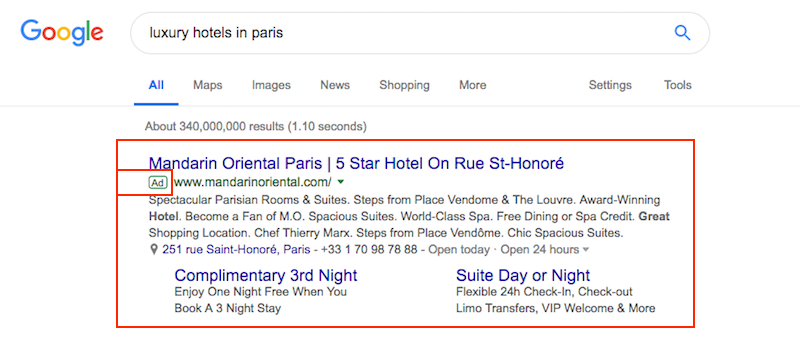
A large number of businesses use Google Ads to fuel growth and get in front of customers when they’re searching Google Search and Maps. It’s a popular online marketing platform since advertisers only pay for results, like clicks to a website or calls to a business.
Google processes over 3.5 billion searches per day which makes the online search behemoth a prime location to find new customers.
If you are new to using Google Ads and decided to hold off on hiring a Google Ads expert, freelancer, or digital marketing agency, you may find yourself stuck when it is time to create ad copy. If you’ve ever struggled with finding the right words to market your business online we know how it feels.
Due to the limited number of characters available, it is rather difficult to describe all the features and benefits of your products and services and convince online searchers they should click on your ad.
However, properly formulated ad copy will help you save advertising dollars on your next PPC campaign by increasing click through rate (CTR), reducing cost per click (CPC) and improve key performance indicators.
18 Google Ads copywriting tips for small business
If you are ready to try your hand at it, here are 18 Google Ads copywriting tips that will help you grab attention, increase metrics, and compel people to take action.
Discover how you can add value
1. Scrutinize competitive Google Ads
Analyze your brand offering as it relates to your top 3 or 5 competitors. This will allow you to hone in on your unique selling points (USPs), learn how competitors are positioning themselves and discover ways that you can stand apart from the crowd.

2. Focus on the benefits
Tell potential customers what’s special about your services and more importantly how you can help them. Let people know what they will get if they click on your Google ad and how it will impact their lives. Consider including discounts and incentives in your paid search ads as well. Free delivery, BOGO promotions and free samples can go a long way.
3. Focus on your target audience
Before you launch a Google Ads campaign, or any digital marketing campaign for that matter, its important to conduct audience research. Audience targeting and segmentation options are available to PPC advertisers who want to understand if there are any subgroups of their target customers who have demonstrated certain in-market behavior and purchase intent.
Essentially, you can reach potential customers while they’re actively browsing, researching or comparing the types of products you sell. The more personalized your ad copy the better response you will get.
4. Add social proof and build trust
People tend to be friendlier towards brands that are verified by other people. You can quickly build trust by sharing how many people use your products and services. Share a brief customer testimonial too.

Grab the attention of online searchers
5. Use emotional triggers in your ad copy
It is not a secret that people are easily influenced by emotional triggers in advertising. This method has been successfully used by marketers for quite a long time and here are the top four emotions that will convince people to click and convert: Anger, Disgust, Affirmation, Fear
6. Appeal to self-interest or FOMO
A number of philosophical, psychological, and economic theories examine the role of self-interest as it relates to human action. The research tells us what we already know: people care about themselves and their ego.
As a marketer, you can exploit this to provoke an emotional reaction. Simply by telling people they have a right to have something you can persuade today’s generation to at least give it a try. Otherwise, employ FOMO (fear of missing out) tactics with specific offers and deadlines.
7. Tell a good story
What’s the greatest benefit of brand storytelling? Higher engagement with your ad copy; and as a result–your business. Help people understand your “why” in written form. Engage with them in the first line of the ad and tell the rest in the ad description.
8. Reduce risk and fear
It is normal for people to hesitate to make decisions if there’s a chance they could regret it in the future. This is especially true for products and services with low brand awareness or high prices. Eliminate the hesitation barrier by offering customers a free trial or a 100% guarantee or your money back, if they are unsatisfied with a purchase.
9. Ask the right questions
Do you know the power of the question? Whenever you read any, you tend to answer it subconsciously. It works the same with your potential clients. If his answer will be similar to what you are offering it will definitely increase your CTR.
Be relevant
10. Pay attention to your Google Ad headlines
Assuming you’ve conducted keyword research, include keywords from your campaign lists in your headlines to make your ad more relevant. People tend to click on links they sure will have what they are looking for. Keywords in the headline will assure searches you have what they are looking for.
11. Reflect on your customers’ end goal
Consider what your potential customer wants and how their query will look. Then you’ll be able to reformulate it into a powerful headline that will meet their expectations. Mirror their objectives in your Google Ad to become super relevant. For example, if someone is searching for the best small business credit card with travel rewards, a Google Ad result like the one below speaks to their direct objectives (i.e. “What’s in it for me?”)

12. Get specific with numbers and statistics
Most of your potential customers know how much they want to pay for products and services, so be upfront. By sharing numbers and statistics your ad looks more credible. Additionally, try to avoid round numbers. Write 52 instead of 50 or 12 instead of 10. Test it and see what happens.
13. Create keyword-rich display URLs
Ad copy with keyword-based URLS appear more relevant to online searchers. The more specific your ad copy and URL address what customers are looking for–the better.

14. Match ad copy to your landing page
Imagine if you’re searching for designer bags on Google, click-through on a Google Ad and land on a website that is promoting knock-offs. This is how customers feel when they land on landing pages that are inaccurate or blatantly don’t live up to the hype of the ad.
Landing pages are really important when it comes to the quality of your site traffic. They must be easy to navigate and most importantly have the information from your ad and be built to convert.
Pay close attention to ad format and style
15. End the first description line with punctuation
By ending your description line with punctuation (full stop, question mark – whatever suits you) your ad could receive an elongated headline if it earns a space in the top three spots.
16. Capitalize your sentences
Writing ad copy in all capital letter is forbidden, it is like you’re LITERALLY SHOUTING at someone online. However, you can use title case to make your ad more visible and increase CTR.
17. Don’t forget a call to action
You need to guide potential customers on the next best steps to take so give them some advice: Order Today!, Learn More!, or Get 30% Off Today!
18. Use ad extensions
Don’t hesitate to tell online searchers more about your business, it’s not only additional info for customers, but it makes your ad bigger and more visible. Add your toll-free phone number in case you are a local business with customers who feel more comfortable with a phone consultation, or need directions, etc.
Daria Shilina, a Digital Account Manager at adCookie, helps brands discover the true power of digital advertising. Together with her colleagues she creates strong digital strategies and assist clients who want to achieve the best results online. She leverages the accumulated knowledge she gained working as a media planner for 2+ years and studying integrated communications and communication management. Connect with @adCookie on Twitter.
© YFS Magazine. All Rights Reserved. Copying prohibited. All material is protected by U.S. and international copyright laws. Unauthorized reproduction or distribution of this material is prohibited. Sharing of this material under Attribution-NonCommercial-NoDerivatives 4.0 International terms, listed here, is permitted.













